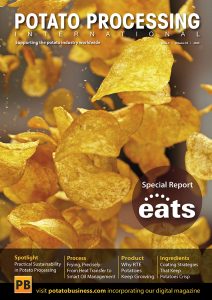Potato Exports to Asia Are on the Rise

Snacking potato products are in growth across Asia, driven by busy urban workers, consuming on the go, AHDB’s latest Market Intelligence Horizon report has revealed recently. Across the region, diets are shifting from fresh table potatoes to processed products. Domestic processing capacity and production of processing potato varieties is often insufficient to meet this growing demand, leaving many countries reliant on imported products. Frozen potato products are in hot demand in regions where Western-style fast-food restaurants are becoming more common.
Foodservice is driving demand for frozen potato products, with French fries becoming more popular with customers who have increasingly Westernized diets. Japan imports the highest amount of frozen potato products in the region, shipping 354,000 tons in 2018, nearly all of which were French fries. Most of the domestic potato supply is consumed as table potatoes, with only 1% going into the production of French fries.
The US supplies the bulk of frozen French fry imports, but under the new EU–Japan trade deal, tariffs will be slowly reduced to zero over the next four years, making EU exports more competitive. Post-Brexit, the UK has an opportunity to discuss access rights but should be aware of these types of existing EU trade deals.
China and South Korea have also seen strong growth in the import of frozen potato products as consumption expands beyond quick service restaurants (QSR) to become more mainstream. In China, most QSR outlets serve Chinese cuisine (75%), but American is the second most popular cuisine type (13%), according to figures from GlobalData.
The Snacking Phenomenon
Longer working hours and rising disposable incomes are expected to drive growth in savory snacking across Asia. India is a key market, with growing incomes and a cultural tradition of snacking between meals. The Indian savory snacking market is forecast to record a volume CAGR of 9.7% from 2017–2022 (GlobalData). Ethnic/traditional snacks take half of the value share in India, but potato chips make up 34% and processed snacks 11%.
Across the Asia-Pacific region, potato chips were worth USD6.2bn in 2017 and are forecast to grow to USD10bn by 2022, with India, China and Japan expected to contribute the most to growth. Flavors tend to reflect local cuisine – cheese and onion are unlikely to get Asian hearts racing. Spicy masala flavors are popular in India, while in Japan, seafood flavors are very common, including squid, seaweed and shrimp. Asian consumers also show a greater propensity for experimentation in their chips flavors – some more unusual seasonings include mint (India), cucumber, blueberry (both China), pickled plum (Japan) and Cola (Korea).

















